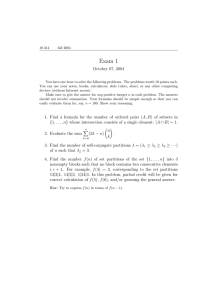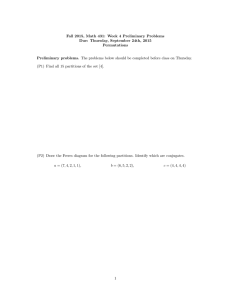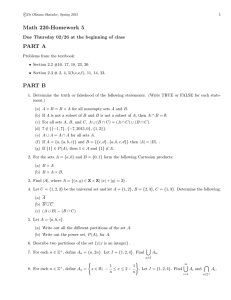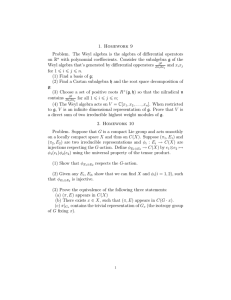On the Various Realizations of the Basic Representation of A of Partitions
advertisement
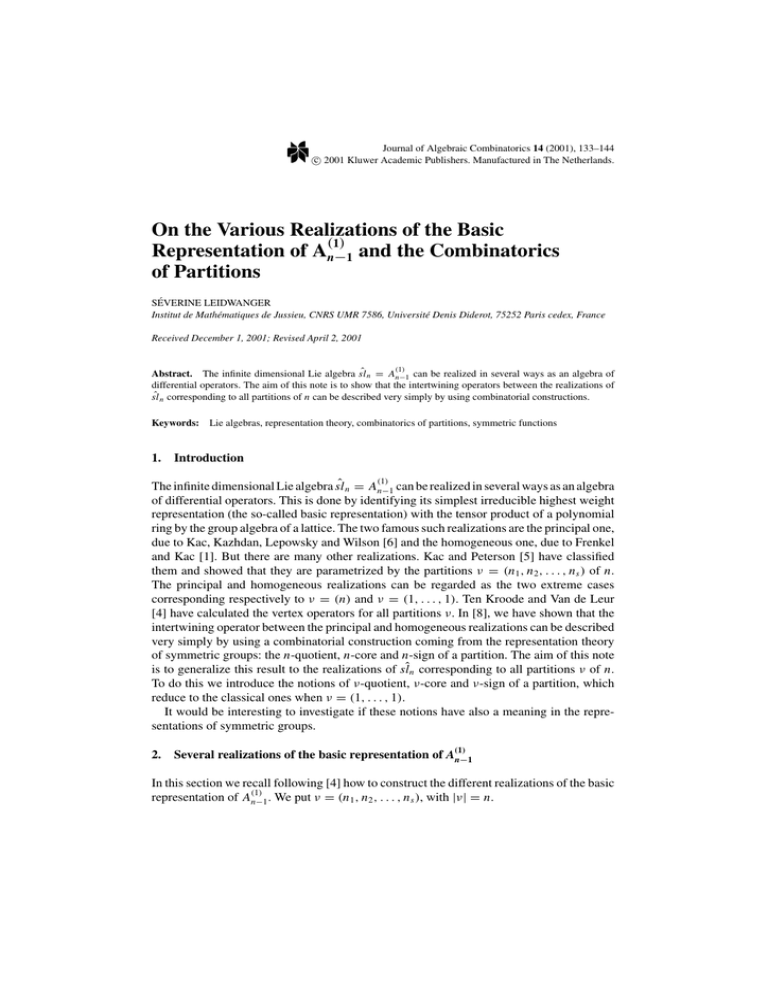
Journal of Algebraic Combinatorics 14 (2001), 133–144
c 2001 Kluwer Academic Publishers. Manufactured in The Netherlands.
On the Various Realizations of the Basic
Representation of A(n1−) 1 and the Combinatorics
of Partitions
SÉVERINE LEIDWANGER
Institut de Mathématiques de Jussieu, CNRS UMR 7586, Université Denis Diderot, 75252 Paris cedex, France
Received December 1, 2001; Revised April 2, 2001
Abstract. The infinite dimensional Lie algebra slˆ n = A(1)
n−1 can be realized in several ways as an algebra of
differential operators. The aim of this note is to show that the intertwining operators between the realizations of
slˆ n corresponding to all partitions of n can be described very simply by using combinatorial constructions.
Keywords: Lie algebras, representation theory, combinatorics of partitions, symmetric functions
1.
Introduction
The infinite dimensional Lie algebra slˆ n = A(1)
n−1 can be realized in several ways as an algebra
of differential operators. This is done by identifying its simplest irreducible highest weight
representation (the so-called basic representation) with the tensor product of a polynomial
ring by the group algebra of a lattice. The two famous such realizations are the principal one,
due to Kac, Kazhdan, Lepowsky and Wilson [6] and the homogeneous one, due to Frenkel
and Kac [1]. But there are many other realizations. Kac and Peterson [5] have classified
them and showed that they are parametrized by the partitions ν = (n 1 , n 2 , . . . , n s ) of n.
The principal and homogeneous realizations can be regarded as the two extreme cases
corresponding respectively to ν = (n) and ν = (1, . . . , 1). Ten Kroode and Van de Leur
[4] have calculated the vertex operators for all partitions ν. In [8], we have shown that the
intertwining operator between the principal and homogeneous realizations can be described
very simply by using a combinatorial construction coming from the representation theory
of symmetric groups: the n-quotient, n-core and n-sign of a partition. The aim of this note
is to generalize this result to the realizations of slˆn corresponding to all partitions ν of n.
To do this we introduce the notions of ν-quotient, ν-core and ν-sign of a partition, which
reduce to the classical ones when ν = (1, . . . , 1).
It would be interesting to investigate if these notions have also a meaning in the representations of symmetric groups.
2.
Several realizations of the basic representation of A(1)
n−1
In this section we recall following [4] how to construct the different realizations of the basic
representation of A(1)
n−1 . We put ν = (n 1 , n 2 , . . . , n s ), with |ν| = n.
134
LEIDWANGER
We follow the notation of [3]. Let Ā(1)
n−1 be the subalgebra of ā∞ consisting of the matrices
A = (aij )i, j∈Z such that
n
ai+n, j+n = aij ,
ani+k,n j+k = 0,
(i, j ∈ Z).
(1)
k=1
(1)
(1)
The subalgebra Ā(1)
n−1 ⊕ Cc of a∞ is isomorphic to An−1 , and the affine Lie algebra An−1 is
(1)
obtained by adjoining to An−1 the degree operator
D=−
i i∈Z
n
E ii ,
(2)
where the E ij are the units matrix. The Chevalley generators ei , f i , h i for i ∈ {0, . . . , n − 1}
are
ei =
E i,i+1 ,
k≡i mod n
fi =
E i+1,i ,
h i = [ei , f i ] .
(3)
k≡i mod n
We denote by h the Cartan subalgebra generated by h 0 , . . . , h n−1 , D.
To describe how to associate a Heisenberg subalgebra denoted by Hν , to a partition
ν = (n 1 , n 2 , . . . , n s ) of n we need the construction of A(1)
n−1 as a loop algebra.
−1
A(1)
n−1 is the central extension (C[t, t ] ⊗C An−1 ) ⊕ Cc of the loop algebra of An−1 , the
bracket being given by
[t k ⊗ x, t l ⊗ y] = t k+l ⊗ (x y − yx) + kδk,−l tr (x y) c,
(x, y ∈ An−1 , k, l ∈ Z), (4)
(see [3], 7.1). The isomorphism ι between the two realizations is
ι(t j ⊗ Er,s ) =
Er +ni, s+ni+n j,
(1 ≤ r, s ≤ n − 1).
(5)
i∈Z
In this construction the degree operator acts by
[D, ι(t k ⊗ x)] = k ι(t k ⊗ x) ,
(x ∈ An−1 , k ∈ Z).
(6)
Then, we need to change the usual basis of gl(n), {E i, j }1≤i, j≤n . We will work with
partitions in blocks of an n × n-matrix.
COMBINATORICS OF PARTITIONS
135
To ν we associate the matrix
B11 B12 . . . B1s
..
.
B21 B22 . . .
..
..
..
.. ,
.
.
.
.
.
..
..
..
.
.
.
.
.
Bs1 . . . . . . Bss
where Bij is a block of size n i × n j . The standard basis for the (i, j)th-block is the set of
i, j
matrices {E p,q }1≤ p≤ni ,1≤q≤n j defined by
E i,p,qj := E n 1 +···+ni−1 + p,n 1 +···+n j−1 +q .
The commutation relations become
i, j
k,l
k, j
E p,q , Er,s
= δ j,k δq,r E i,l
p,s − δi,l δ p,s E r,q .
We can now return to A(1)
n−1 . In its realization as a loop algebra we put for 1 ≤ l ≤ n i and
1≤i ≤s
αil(k) = t k ⊗ Ai,l
where Ai,l corresponds to a matrix with zero entries, except on its (i, i)th diagonal block.
This block is made of 4 blocks of size l × (n i − l), l × l, (n i − l) × (n i − l) and (n i − l) × l:
0 ... 0 1
. .
..
. . ...
..
.
0 . . . 0
t
0 ...
.. . .
..
.
.
.
t
0
1
.
0
..
.
... 0
We then define for 1 ≤ i ≤ s − 1
βi(k) =
Theorem 1
1 (k)
1 (k)
α −
α
.
n i i,ni n i+1 i+1,ni+1
[4, 5]
(i) For ν = (n 1 , . . . , n s ) the subalgebra generated by the elements αil(k) , β (k)
j for k ∈ Z, 1 ≤
i ≤ s, 1 ≤ l < n i , 1 ≤ j ≤ s − 1 is an Heisenberg subalgebra Hν .
136
LEIDWANGER
(ii) The Heisenberg subalgebras Hν form a complete non-redundant list of Heisenberg
subalgebras of A(1)
n−1 up to conjugacy.
In particular, the principal Heisenberg subalgebra is associated to ν = (n) and the homogeneous one to ν = (1, . . . , 1).
There is a realization of the basic representation of A(1)
n−1 associated to each Heisenberg
subalgebra.
We then want to construct an intertwiner between all this realizations, and to do this we
introduce combinatorial notions.
3.
Combinatorial notions
A partition λ = (λ1 , . . . , λt ) is a weakly decreasing sequence of nonnegative integers. We
denote by P the set of partitions, by |λ| the weight of λ and by l(λ) = t the length of λ.
3.1.
ν-core, ν-quotient, ν-sign
Fix ν = (n 1 , . . . , n s ) a partition of n. To any partition λ, we associate the ν-core λ(ν) , the
ν-quotient λ(ν) and the ν-sign ν (λ) of λ. These notions generalize the classical notions of
n-core, n-quotient and n-sign of a partition λ (see [2, 11]) which correspond to the case
ν = (1, . . . , 1).
To λ we associate an infinite decreasing sequence
θ (λ) = (λ1 , λ2 − 1, λ3 − 2, . . .) = (θ 1 , θ 2 , . . .).
Such a decreasing sequence can be encoded by a configuration of beads on an abacus
with s infinite runners numbered 0, . . . , s − 1 from left to right. The possible positions of
a bead on the abacus are indicated by integer labels, the ith-runner being labelled by all
integers congruent modulo n to the numbers −(n s +· · ·+n s−i+1 ), −(n s +· · ·+n s−i+1 +1),
. . . , −(n s + · · · + n s−i+1 + n s−i − 1).
Then one encodes θ by putting a bead in position θ i for each i. Note that all but a finite
number of negative positions are occupied by a bead. Thus, for λ = (6, 5, 5, 3, 3, 2, 1),
n = 3 and ν = (2, 1), we have
θ (λ) = (6, 4, 3, 0, −1, −3, −5, −7, −8, . . .)
and the corresponding (2, 1)-abacus is shown in the left-part of figure 1.
It is convenient to call ‘holes’ the unoccupied positions with a label i ≤ 0, and ‘particles’
the occupied positions with a label i > 0 (see the infinite wedge construction in [7]). By
definition, there are as many holes as particles.
One can now read the ν-core of λ on the corresponding abacus. This is the partition λ(ν)
corresponding to the bead configuration obtained by sliding the beads up as high as possible
on their respective runners. Thus, continuing our previous example, the bead configuration
COMBINATORICS OF PARTITIONS
Figure 1.
137
The (2, 1)-abacus of λ = (6, 5, 5, 3, 3, 2, 1) and of its (2, 1)-core λ(2,1) = (3, 1).
of the (2, 1)-core of λ = (6, 5, 5, 3, 3, 2, 1) is shown in the right-part of figure 1, so that
λ(2,1) = (3, 1).
This description shows that there is a bijection between the set Cν of ν-core partitions (that
is, partitions
µ such that µ = µ(ν) ) and the set of s-tuples (a0 , a1 , . . . , as−1 ) of integers such
that i ai = 0. It is obtained by defining ai to be either minus the number of holes or plus the
number of particles on runner s − 1 − i of the bead configuration corresponding to µ ∈ Cν .
as−1
±1
Hence, one can associate to each µ ∈ Cν a monomial q0a0 · · · qs−1
in C[q0±1 , . . . , qs−1
].
We can then define the ν-quotient of λ. It is a (s − 1)-tuple of partitions denoted by
λ(ν) = (λ1 , . . . , λs−1 ). We are going to read the ith part of the ν-quotient on the s − 1 − ith
runner. For each particle, in decreasing order, we count all the holes above it on the same
runner. This gives us a partition. For our example we have λ0 = (4, 2) and λ1 = (1, 1, 1, 1).
Proposition 1 The map λ → (λ(ν) , λ(ν) ) is a bijection from P to Cν × P s .
Proof: It is obvious by the construction of the ν-core, the ν-quotient.
✷
To finish we now define the ν-sign of λ by using two different orderings of the beads of
its bead configuration. Since in our setting the number of these beads is infinite, we have
138
LEIDWANGER
Figure 2.
The two numberings of the finite bead configuration of λ = (6, 5, 5, 3, 3, 2, 1).
to restrict to a finite subset. An incomplete row with beads on all remaining integers is
also without holes. To obtain the finite part of the abacus we discard all the negatives rows
without holes such that the first row discarded is a complete row. The finite part gives us
the finite bead configuration of λ. The first way of numbering the beads is given by the
natural ordering of their labels. For the second one, we sort the beads into different layers,
the jth layer ( j ≥ 1) consisting of those beads which have j − 1 beads above them on their
respective runners in the finite bead configuration. In this numbering, called π -numbering,
a bead on runner i and layer j is numbered before a bead on runner i 1 and layer j1 if
and only if j < j1 , or j = j1 and i > i 1 . When we compare these two numberings, we get
a permutation πν whose sign is denoted by ν (λ). This is the ν-sign of λ. In our running
example, figure 2 shows the natural numbering (left) and the π -numbering (right). Thus
1
π(2,1) (λ) =
1
so that (2,1) (λ) = 1.
2
3
3
5
4
2
5
7
6
4
7
6
8
9
9
,
8
COMBINATORICS OF PARTITIONS
3.2.
139
Symmetric functions
We review the necessary background in the theory of symmetric functions (see [9]). We
denote by Sym(X ) the algebra of symmetric functions in an infinite set of variables
X = {x1 , x2 , . . .} with coefficients in C. When there is no danger of confusion we shall
omit X and simply write Sym. The algebra
Sym can also be regarded as the polynomial
ring Sym = C[ pk ; k ∈ N∗ ] where pk = i xik is the power sum symmetric function. An
important linear basis of Sym is the basis of Schur’s S-functions
sλ =
χλ (µ)
zµ
µ
pµ
where for λ and µ = (1m 1 · · · r m r ) two partitions of m, we put
pµ = p1m 1 · · · prm r ,
z µ = 1m 1 m 1 ! · · · r m r m r !,
and χλ (µ) is the irreducible character χλ of Sm evaluated on the conjugacy class of cycletype µ.
Let · , · be the scalar product of Sym defined by sλ , sµ = δλµ , where δλµ is Kronecker’s
symbol. We denote by Df the adjoint of the multiplication by f with respect to · , ·, that is,
Df g, h = g, f h,
( f, g, h ∈ Sym).
Df is in fact a differential operator since we have for f = f ( p1 , p2 , . . .)
Df = f
∂
∂
∂
,2
,...,n
,... .
∂ p1 ∂ p2
∂ pn
The multiplication of an S-function by a power sum pk is conveniently described as
follows. It is a particular case of a formula of Muir for multiplying an S-function by a
monomial symmetric function (see [10]).
Let τ = (τi )i≥1 be an infinite sequence of pairwise distinct integers such that τi = −i + 1
for i large enough. Then there is a finite permutation w such that w(τ ) = θ (λ) for some
partition λ. It is convenient to introduce the notation
Sτ = sgn wsλ ,
(7)
and to extend this notation to sequences τ such that τi = τ j for some pair i, j, by putting
Sτ = 0 in this case. Then (see e.g. [9] I 3, Ex. 11)
pk Sτ =
Sτ +ki
(8)
i≥1
where i = (δij ) j≥1 . Clearly, only a finite number of summands have all their parts pairwise
distinct and the above sum is finite.
140
LEIDWANGER
The partitions µ such that sµ occurs in pk sλ are those obtained from λ by addition of a
ribbon (or rim-hook) of length k. The sign of sµ is then equal to the sign of the permutation
w such that sτ +ki = sgn ws λ . Similarly, we have
D pk Sτ =
Sτ −ki .
(9)
i≥1
Finally, we denote by Sym(X 1 , . . . , X j ) the C-algebra of functions of j sets of variables X 1 , . . . , X j , symmetric in each set separately. In other words, Sym(X 1 , . . . , X j ) =
C[ pk (X i ); k ∈ N∗ , 1 ≤ i ≤ n]. A linear basis of this algebra is given by the products sα1 (X 1 )
· · · sα j (X j ) where α 1 , . . . , α j are arbitrary partitions.
We denote respectively by p̂k (X i ) and D pk (X i ) the endomorphisms
p̂k (X i )( f ) = pk (X i ) f,
D pk (X i ) ( f ) = k
∂
f,
∂ pk (X i )
( f ∈ Sym(X 1 , . . . , X j )).
More generally, for g ∈ Sym(X 1 , . . . , X j ), we define ĝ and Dg by expanding g as a polynomial in the variables pk (X i ) and taking the corresponding polynomials in the p̂k (X i ) or
D pk (X i ) .
4.
Construction of the intertwiners
We generalize to all the realizations of the basic representation of A(1)
n−1 constructed in
[4] the results obtained for the homogeneous one in [8]. Thoughout this section we put
ν = (n 1 , n 2 , . . . , n s ), with |ν| = n.
In fact, the aim of this section is to show that the notions of ν-sign, ν-quotient and ν-core
introduced before allow to give a simple combinatorial description of the isomorphism
between constructions of [6] (for the principal realization) and [4] (for the others) of the
basic representation of A(1)
n−1 .
Let (0 , . . . , n−1 , δ) denote the basis of h∗ dual to (h 0 , . . . , h n−1 , D). We are going to
describe the several explicit realizations of the basic representation of A(1)
n−1 linked to the several Heisenberg subalgebras introduced in Section 2. This representation is the irreducible
representation L(0 ) with highest weight 0 (see [3] 9.3, 14).
(1)
We consider the Fock representation κP of A(1)
n−1 , obtained by restricting to An−1 the action
of a∞ on Sym (see [3] or [8]). We have the explicit description of the Chevalley generators
in this representation:
κP (ei )sλ =
µ
sµ ,
κP ( f i )sλ =
ν
sν ,
(10)
where µ (resp. ν) runs through the partitions obtained from λ by removing (resp. adding)
a node with content d ≡ i mod n.
We know (see [8]) that L(0 ) in its principal picture is isomorphic to the subalgebra of
Sym T (n) = C[ pi , i ≡ 0 mod n].
141
COMBINATORICS OF PARTITIONS
We shall now transport this Fock representation into the picture corresponding to the
Heisenberg subalgebra Hν , and describe its unique irreducible component of type L(0 ).
Let us recall that L(0 ) does not remain irreducible by restriction to Hν , we have
L(0 ) ↓Hν (0 ) ⊗C S(Hν− )
(11)
where the space (0 ) is an irreducible module over the Heisenberg subalgebra consisting
of all vectors in L(0 ) which are killed by the αil(k) and βi(k) with k > 0.
We define the C-vector space Bν = M ⊗C Sym(X 0 , X 1 , . . . , X s−1 ) where M is the subas−1
±1
space of C[q0±1 , . . . , qs−1
] with basis {q0a0 · · · qs−1
| a0 + · · · + as−1 = 0}.
We can now introduce the main tool of the construction which is the generalization of
the intertwiner n of [8].
Definition 1 Denote by ν the isomorphism of C-vector spaces given by
ν : Sym(X ) → Bν
as−1
sλ (X ) → ν (λ)q0a0 · · · qs−1
⊗ sλ0 (X 0 ) · · · sλs−1 (X s−1 )
(12)
where a0 , . . . , as−1 are related to λν as in Section 2.1.
The fact that this is indeed an isomorphism of vector spaces results from Proposition 1.
The map ν allows to transport the representation κP of A(1)
n−1 on Sym to a representation
κν on Bν , defined by
κν (x) = ν ◦ κP (x) ◦ −1
ν ,
x ∈ A(1)
n−1 .
For g ∈ Sym(X 0 , . . . , X s−1 ) we define endomorphisms of Bν by
ĝ(m ⊗ f ) = m ⊗ ĝ( f ), Dg (m ⊗ f ) = m ⊗ Dg ( f ),
(m ∈ M, f ∈ Sym(X 0 , . . . , X s−1 )) .
Theorem 2 For k ∈ N, i ∈ {1, . . . , s}, l ∈ {1, . . . , n i − 1}, we have
κν αil(k) = D pl+ni k (X s−i−1 ) ,
κν αil(−k) = p̂ni k−l (X s−i−1 ) k = 0,
1
1
κν βi(k) =
D p (X
D p (X ) ,
)−
n i ni k s−i−1
n i+1 ni+1 k s−i
1
1
κν βi(−k) =
p̂ni k (X s−i−1 ) −
p̂n k (X s−i ) .
ni
n i+1 i+1
(13)
(14)
(15)
(16)
Proof: To prove this result we are going to use the Boson-Fermion correspondence, i.e.
the isomorphism between the realization of L(0 )a∞ in Sym and its realization as an
142
LEIDWANGER
infinite-wedge representation described below (see [3], 14.9). This is the alternative realization of L(0 )a∞ in a space F with basis vectors
u I = u i1 ∧ u i2 ∧ · · · ∧ u ik ∧ · · ·
where I = (i k )k≥1 runs through all decreasing sequences of integers such that i k = −k + 1
for k sufficiently large. Here, u i denotes the canonical basis of CZ on which the matrix units
operate by E ij u k = δ jk u i . The Lie algebra A∞ of Z × Z-matrices with a finite number of
nonzero entries acts on F by derivation, that is,
E ij (u i1 ∧ u i2 ∧ · · ·) = (E ij u i1 ) ∧ u i2 ∧ · · · + u i1 ∧ (E ij u i2 ) ∧ · · · + · · ·
and this extends uniquely to a projective representation of ā∞ , hence to a linear representation of a∞ hence by restriction to a linear representation of A(1)
n−1 .
In fact, here, we use the multicomponent fermionic version of [4]. Instead of the u I we
relabel the basis vector according to ν, we put:
uj (l + nj k) := u n 1 +···+n j−1 +l+nk .
(18)
Then the basis vectors become u i1 (k1 ) ∧ u i2 (k2 ) ∧ · · ·.
We have then to introduce fermionic creation and annihilation operators for the basis
vectors:
ψi (k)(u i1 (k1 ) ∧ u i2 (k2 ) ∧ · · ·) := u i (k) ∧ u i1 (k1 ) ∧ u i2 (k2 ) ∧ · · · ,
∞
ψi∗ (k)(u i1 (k1 ) ∧ u i2 (k2 ) ∧ · · ·) :=
(−1) j δi,i j δk,k j u i1 (k1 ) ∧ u i2 (k2 )
j=1
∧ · · · ∧ u i
(k j ) ∧ · · · .
j
One can easily check the anti-commutation relations of these multicomponent fermions.
One has
if k > 0
ψi (k)ψi∗ (l)
∗
: ψi (k)ψi (l) :=
∗
−ψi (l)ψi (k) otherwise,
The unique isomorphism between the ‘bosonic’ realization Sym and the ‘fermionic’
realization F is the so-called boson-fermion correspondence σ : Sym → F. It sends the
S-function sλ onto the infinite wedge
σ (sλ ) = u θ (λ) .
Using (18) we can easily compute θ (λ) from the multicomponent fermions. Now, following
[4], we have
αil(k) =
: ψi (r )ψi∗ (r + l + n i k) : .
(19)
r ∈Z
143
COMBINATORICS OF PARTITIONS
Then
αil(k) u ν(θ (λ)) =
uI
I
where u ν(θ (λ)) is obtained from u θ (λ) by relabelling it following (18) and u I is obtained from
u ν(θ (λ)) by changing the parts equal to u i (r + l + n i k) into u i (r ) by using (19). Then with
this result, the definition of the ν-quotient, Eqs. (8), (9), and the definition of ν we obtain
the result.
✷
Theorem 2 shows that the representation κν is a realization of the Fock representation of
A(1)
n−1 in which the operators of the subalgebra Hν act by multiplication and derivation with
respect to the variables pni k−l (X s−i−1 ). Hence we have obtained the Fock representation
in the picture corresponding to the Heisenberg subalgebra Hν . It remains to single out the
representation L(0 ) inside Bν .
Theorem 3 The realization of L(0 ) in Bν is obtained by applying ν to the realization
of L(0 ) in Sym. Let A be the subring of Sym(X 0 , . . . , X s−1 ) generated by the power
sums pni k−l (X s−i−1 ) k ≥ 1, 1 < i ≤ s. We have
ν T (n) = M ⊗ A .
Proof: Because of the decomposition (11) we have to prove that M is equal to (0 ).
−1
introduced by [4]. The Q i satisfy the relations:
We use the operators Ti = Q i Q i+1
Q i ψ j (k) = −ψ j (k)Q i if i = j,
Q i ψ ∗j (k) = −ψ ∗j (k)Q i if i = j,
Q i ψi (k) = −ψi (k + 1)Q i ,
Q i ψi∗ (k) = ψi∗ (k + 1)Q i ,
Q i−1 ψ j (k) = −ψ j (k)Q i(−1)
Q i(−1) ψ ∗j (k)
Q i(−1) ψi (k)
Q i(−1) ψi∗ (k)
=
if i = j,
−ψ ∗j (k)Q i(−1)
if i = j,
= −ψi (k − 1)Q i(−1) ,
= ψi∗ (k − 1)Q i(−1) .
Then by [4] we know that (0 ) is isomorphic to the group generated by Ti for 1 ≤ i ≤ s−1.
With the definition of the action of Ti described above on the vacuum vector v0 written in the
multicomponent basis vector and the definition of the ν-core we obtain the desired result.
The fact that S(Hν− ) is isomorphic to A follows from Theorem 2.
✷
References
1. I.B. Frenkel and V.G. Kac, “Basic representations of affine Lie algebras and dual resonance models,” Invent.
Math. 62 (1980), 23–66.
144
LEIDWANGER
2. G. James and A. Kerber, The Representation Theory of the Symmetric Group, Addison Wesley, Reading, MA,
1981.
3. V.G. Kac, Infinite Dimensional Lie Algebras, 3rd ed., Cambridge, UK, 1990.
4. F. ten Kroode and J. Van de Leur, “Bosonic and fermionic realizations of the affine algebra glˆn ,” Commun.
Math. Phys. 137 (1991), 67–107.
5. V.G. Kac and D.H. Peterson, “112 Constructions of the basic representation of the loop group of E 8 ,” Proceedings of the Conference “Anomalies, geometry, topology” Argonne, 1985. World Scientific, Singapore,
1985, pp. 276–298.
6. V.G. Kac, D.A. Kazhdan, J. Lepowsky, and R.L. Wilson, “Realization of the basic representations of the
euclidean Lie algebras,” Adv. Math. 42 (1981), 83–112.
7. V.G. Kac and A.K. Raina, “Bombay lectures on highest weight representations of infinite dimensional Lie
algebras,” World Scientific, Singapore, 1987.
(2)
8. S. Leidwanger, “Basic representations of A(1)
n−1 and A2n and the combinatorics of partitions,” Adv. Math. 141
(1999), 119–154.
9. I.G. Macdonald, Symmetric Functions and Hall polynomials, 2nd ed., Oxford, UK, 1995.
10. T. Muir, A Treatise on the Theory of Determinants, Macmillan, London, 1882.
11. J.B. Olsson, “Combinatorics and Representations of Finite Groups,” Vorlesungen aus dem Fachbereich Mathematik der Universitat GH Essen Heft 20 (1993).
